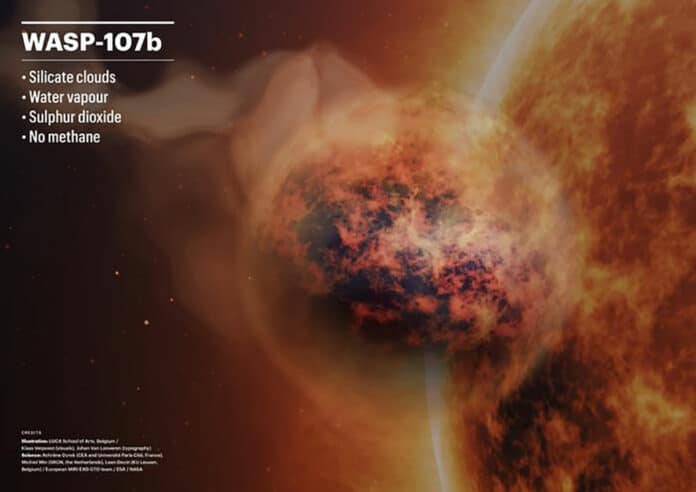The Mid-Infrared Instrument (MIRI) on board the James Webb Space Telescope (JWST) is being used by astronomers all around the world to perform ground-breaking exoplanet observations. Utilizing recent James Webb Space Telescope images, a group of European astronomers, including researchers from the Institute of Astronomy at KU Leuven, studied the atmosphere of the neighboring exoplanet WASP-107b.
A distinct gaseous exoplanet known as WASP-107b orbits a star that is marginally less massive and colder than the Sun. While the planet’s size is much larger than Neptune’s, nearly reaching Jupiter’s size, its mass is similar to Neptune’s.
It is a fluffy planet- its fluffiness allows astronomers to look roughly 50 times deeper into its atmosphere compared to the depth of exploration achieved for a solar-system giant like Jupiter.
When astronomers peered into the planet’s atmosphere, they found water vapor, sulfur dioxide, and silicate sand clouds. These particles reside within a dynamic atmosphere that exhibits vigorous transport of material. But notably, there is no trace of the greenhouse gas methane (CH4).
These discoveries offer vital new information about the chemistry and behavior of this fascinating exoplanet. First, the lack of methane provides a tantalizing peek into the movement of thermal energy in the planet’s atmosphere and suggests that the interior may be warm. Second, a big surprise was the discovery of sulfur dioxide, responsible for the smell of burning matches.
While new climate models of WASP-107b’s atmosphere have shown that the planet’s fluffiness allows sulfur dioxide to accumulate, previous models had predicted that it would not. Due to its colder nature, the host star only releases a small fraction of high-energy photons, yet because of its fluffy nature, these photons can travel deep into the planet’s atmosphere.
The spectral characteristics of water vapor and sulfur dioxide are much reduced from what they would be in a cloudless situation. Clouds at high altitudes block off some of the atmosphere’s sulfur dioxide and water vapor. Although clouds have been inferred on other exoplanets, this is the first time that the chemical makeup of these clouds can be determined with certainty. In this instance, the clouds are made up of tiny silicate particles, a common material to people, and are the main component of sand in many places of the world.
Lead author Prof. Leen Decin of KU Leuven said, “JWST is revolutionizing exoplanet characterization, providing unprecedented insights at remarkable speed. The discovery of clouds of sand, water, and sulfur dioxide on this fluffy exoplanet by JWST’s MIRI instrument is a pivotal milestone. It reshapes our understanding of planetary formation and evolution, shedding new light on our own Solar System.”
The temperature of WASP-107b is around 500 degrees Celsius in the outer atmosphere.
According to lead author Dr. Michiel Min: “The fact that we see this sand clouds high up in the atmosphere must mean that the sand rain droplets evaporate in deeper, very hot layers, and the resulting silicate vapour is efficiently moved back up, where they recondense to form silicate clouds once more. This is very similar to the water vapor and cloud cycle on Earth but with sand droplets. This continuous cycle of sublimation and condensation through vertical transport is responsible for the enduring presence of sand clouds in WASP-107b’s atmosphere.”
Lead author Dr. Achrène Dyrek at CEA Paris said, “JWST enables a deep atmospheric characterization of an exoplanet that does not have any counterpart in our Solar System; we are unraveling new worlds!”
Journal Reference:
- Dyrek, A., Min, M., Decin, L. et al. SO2, silicate clouds, but no CH4 detected in a warm Neptune. Nature (2023). DOI: 10.1038/s41586-023-06849-0
